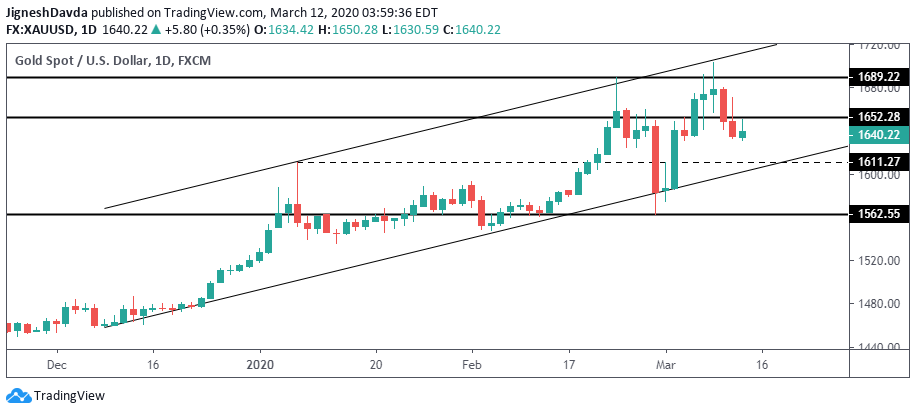Several equity indices around the globe are officially in a bear market while the US 10-year bond yield has plunged to a record all-time low. Yet gold is struggling to make gains beyond highs set ahead of the coronavirus escalation in late February.
Gold is Straying from Typical Correlations
Gold prices have once again veered from common correlations as the yellow metal portrays a somewhat unusual reaction to market conditions.
Prices of gold are typically seen as a safe-haven and move opposite of the equity markets. This has certainly not been the case as of late as the S&P 500 (NYSE:SPY) closed near lows not seen since June on Wednesday while spot gold has pulled back about 4% from its recent high.
Further, comparing the momentum of the decline in equities with the rally in gold prices over the last few weeks, it’s quite clear that risk sentiment is not the primary driver for gold at the moment.
Another common correlation is between gold and bonds. Once again, some correlation is seen, but there is enough evidence to make a case that the urgency seen in bond price fluctuations are not seen in gold.
The 10-year yield showed a single day drop greater than 50% at one point on Monday. Gold prices do seem to be tracing out the general direction of bonds but bear in mind that the 10-year yield is about four standard deviations below its average over the last six months.
In comparison, gold prices are currently testing support from the 20-day moving average which is a far stretch from the breakout in treasury yields.
Lastly, USD/JPY fell to lows not seen since late 2016 earlier this week. The currency pair recovered the losses on Tuesday but fell under pressure once again after running into resistance at 105.50.
The turn lower from resistance has led to a decline back to negative territory while gold prices have diverged from the inverse correlation and trade a fair distance below this week’s open.
Margin-Call Related Weakness?
Several media outlets are floating a narrative that gold prices are experiencing weakness as traders are covering profitable positions in the yellow metal to meet margin calls in losing equity positions.
This narrative may have some merit, but there are several counter-arguments to it.
For starters, if the yellow metal was subjected to selling pressure under these circumstances, it is unlikely to happen again. Traders usually aren’t in the habit of covering profitable positions to support losing ones. It goes against every commonly known trading adage on the matter.
In fact, any experienced trader would do the opposite. Cover losing positions in equities to buy gold, an asset that has been in a strong uptrend even before the Coronavirus chaos hit the equity markets. In other words, the same narrative used to describe weakness in precious metals can be used to make a theoretical argument for strength.
If the argument is that retail traders, who often don’t follow the same practices as professional traders, are to blame for the margin-call related activity, a counter-argument can be made there as well.
Consider the number of retail traders that are invested in broad equity market ETF’s like Vanguard funds. These ETF’s typically are not leveraged to begin with. Further, it begs the question, how many of these Vanguard investors have sizable positions in gold?
The bottom line here is that the margin-call related weakness is a tough argument, especially considering that positioning data that stands to support the argument gets released well after the fact.
The Impacts of Fiscal Stimulus
An alternative view of why gold prices have seen unusual downside pressure in the face of a market crisis is related to fiscal stimulus.
Up until now, precious metals have rallied on the prospects of lower rates. Recall that the price of gold made an important technical breakout just as the Fed shifted to a dovish stance over the summer of 2019.
Legendary investor Ray Dalio wrote an article this week that discussed the importance of a correlated effort with both fiscal and monetary policy easing, and how it historically proved effective in similar situations that the markets are currently facing.
There was an interesting point made in the article – “The scale of the support should be in line with the scale of the crisis. It will increase the deficit which, all else being equal, will raise interest rates.”
The emphasis here is “will raise interest rates”. The theory is that if governments around the world start implementing easing measures through fiscal policy, they will be forced to issue more bonds. This stands to drive down bond prices which in turn increases bond yields.
Back to the earlier point about gold prices breaking out at the same time, the Fed made it clear it was going to shift from a hiking cycle to an easing cycle. A rise in bond yields can arguably remove the catalyst that has been driving precious metals higher since the summer.
Fiscal Stimulus is the Next Logical Step to Combat the Virus
With several central banks already facing a hurdle with interest rates at historic lows, there appears to be a high probability that governments will utilize fiscal stimulus to soften the economic blow expected as a result of the Coronavirus.
US President Trump is already in the process of trying to implement a payroll tax cut and provide relief for hourly wage workers. Granted, he is facing some hurdles, but it’s on the radar.
The Bank of England delivered an emergency 50 basis point rate cut yesterday. What’s most interesting is the timing of it all. The markets reasonably expected action after the G7 meeting last week and were disappointed when the BoE didn’t push forward with a rate cut.
Instead, the MPC decided to wait until yesterday, the same day the UK released its budget which revealed 30 billion pounds worth of fiscal stimulus to aid in offsetting the negative impact the virus is expected to have.
The ECB meets later today and President Lagarde has shown a similar line of thinking. Lagarde knows cutting rates won’t do much as they are already in negative territory.
Several analysts expect more QE and it would be surprising if the ECB didn’t deliver on this front. The real question is, will Europe follow the UK, and what the US is trying to do, and implement fiscal stimulus.
The Financial Times reported yesterday that Lagarde has been asking European governments to do exactly that.
During Draghi’s tenure, he continuously pleaded for fiscal stimulus after it became clear that the unconventional monetary policy measures the central bank had implemented weren’t providing the desired effect of bringing inflation up to target levels on a sustained basis.
The big difference this time around with Lagarde is that the Coronavirus presents a larger threat, to which governments may respond to.
Technical Analysis

Gold Daily Chart
Gold prices have been trending lower and are testing the 20-day moving average at the time of writing.
The ECB meeting stands to increase the already volatile price swings seen over the past few days.
A rising trend channel, best seen on a 4-hour chart, has been encompassing price action since the middle of December. Support is seen at the lower bound of the trend channel, currently around $1611.
The same level reflects a spike high from early January. As well, the 200 moving average on a 4-hour chart falls near the horizontal level to create an even greater confluence of support.
Gold bulls will want to see the yellow metal hold above this support in the week ahead.
To the upside, the February spike high of $1689 is considered a major hurdle. It will likely take a break above it to confirm that the uptrend remains intact.
While it is too soon to start looking at monthly charts, keep in mind that XAU/USD posted an exhaustion candle in February. In this context, gold prices are at great risk if they fall into negative territory for March.
In other words, a decline below the March monthly open of $1585, while still a fair distance away, would offer a strong bearish signal.
